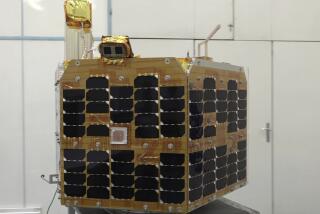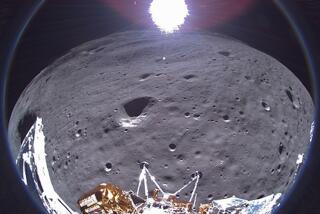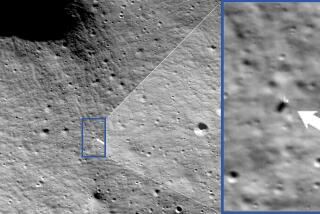Errant Satellite Sent to Moon in Attempt to Correct Orbit
- Share via
In a unique experiment, an aerospace company has sent a communications satellite out of its wobbly Earth orbit and on its way to the moon for a slingshot maneuver to bring it back to a stable path above the equator.
Hughes Space and Communications Co. said Friday that engineers at its mission control center in El Segundo fired the satellite’s rockets Thursday, sending it toward the moon.
It said mission controllers had confirmed that the spacecraft was on its way to the moon by using radio signals received on the ground and by telescope observations.
“This is the first known lunar mission involving a communications satellite and the first mission financed by a nongovernmental entity,” Hughes said in a statement.
It is also the first salvage effort of its type.
The HGS-1 satellite was launched Dec. 25 from Baikonur in Kazakhstan atop a Proton rocket. While in flight the rocket malfunctioned, leaving the satellite in an unusable elliptical orbit.
The Asia Satellite Telecommunications Agency (ASIASat), a Hong Kong-based company that had bought the satellite from Hughes and paid for its launch, recovered $200 million from a consortium of 27 insurance companies.
ASIASat had intended to use the satellite for television and other communications in Asia.
Hughes engineers devised the salvage mission and the company approached the insurers with their plan. The insurers gave Hughes title to the satellite in return for a share of the profits if it can be put to use.
Thursday’s two-minute burn followed a series of shorter firings to raise the satellite’s altitude in preparation for its journey to the moon.
Hughes said it expected the satellite to reach the moon in eight days, traveling at 24,000 mph. It will swing around the moon, coming as close as 5,000 miles above the lunar surface.
The slingshot maneuver uses the moon’s gravity to increase the spacecraft’s speed as it comes around the moon, and then sends it hurtling back toward Earth.
The satellite should reach a stable, geosynchronous orbit over the equator May 16, Hughes said.
The rocket motors may be fired periodically to fine-tune the satellite’s trajectory and will also be used as brakes to put the HGS-1 in its final orbit.
Asked why the rocket motors could not simply have been used to put the satellite in a working orbit without going to the moon, a Hughes spokeswoman said such a maneuver would have burned up all the rocket’s fuel.
Spokeswoman Fran Slimmer said engineers would start tests on the satellite when it reached its new orbit and would know by the end of May if they had been successful.
More to Read
Sign up for Essential California
The most important California stories and recommendations in your inbox every morning.
You may occasionally receive promotional content from the Los Angeles Times.










